Detecting h-index manipulation through self-citation analysis
- PMID: 21472020
- PMCID: PMC3043246
- DOI: 10.1007/s11192-010-0306-5
Detecting h-index manipulation through self-citation analysis
Abstract
The h-index has received an enormous attention for being an indicator that measures the quality of researchers and organizations. We investigate to what degree authors can inflate their h-index through strategic self-citations with the help of a simulation. We extended Burrell's publication model with a procedure for placing self-citations, following three different strategies: random self-citation, recent self-citations and h-manipulating self-citations. The results show that authors can considerably inflate their h-index through self-citations. We propose the q-index as an indicator for how strategically an author has placed self-citations, and which serves as a tool to detect possible manipulation of the h-index. The results also show that the best strategy for an high h-index is publishing papers that are highly cited by others. The productivity has also a positive effect on the h-index.
Figures
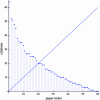




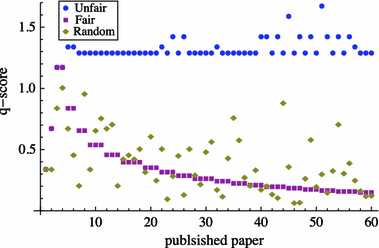
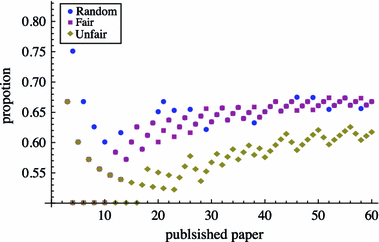
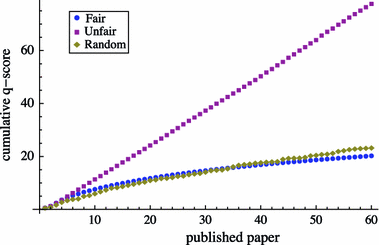


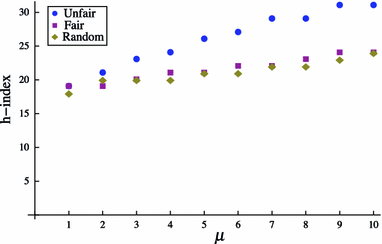
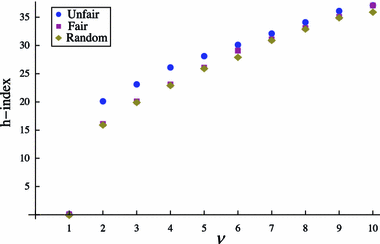

Similar articles
-
Scientific output quality of 40 globally top-ranked medical researchers in the field of osteoporosis.Arch Osteoporos. 2018 Mar 26;13(1):35. doi: 10.1007/s11657-018-0446-4. Arch Osteoporos. 2018. PMID: 29582219 Free PMC article.
-
What Effect Does Self-Citation Have on Bibliometric Measures in Academic Plastic Surgery?Ann Plast Surg. 2016 Sep;77(3):350-3. doi: 10.1097/SAP.0000000000000585. Ann Plast Surg. 2016. PMID: 26101989
-
Prevalence and Impact of Self-Citation in Academic Orthopedic Surgery.Am J Orthop (Belle Mead NJ). 2018 Mar;47(3). doi: 10.12788/ajo.2018.0015. Am J Orthop (Belle Mead NJ). 2018. PMID: 29611850
-
Improved citation status of World Journal Gastroenterology in 2004: Analysis of all reference citations by WJG and citations of WJG articles by other SCI journals during 1998-2004.World J Gastroenterol. 2005 Jan 7;11(1):1-6. doi: 10.3748/wjg.v11.i1.1. World J Gastroenterol. 2005. PMID: 15609387 Free PMC article. Review.
-
Highly cited articles in health care sciences and services field in Science Citation Index Expanded. A bibliometric analysis for 1958 - 2012.Methods Inf Med. 2014;53(6):446-58. doi: 10.3414/ME14-01-0022. Epub 2014 Oct 10. Methods Inf Med. 2014. PMID: 25301516 Review.
Cited by
-
Assessments of Research Competencies for Clinical Investigators: A Systematic Review.Eval Health Prof. 2021 Sep;44(3):268-278. doi: 10.1177/0163278719896392. Epub 2019 Dec 23. Eval Health Prof. 2021. PMID: 31867997 Free PMC article.
-
Immigration: analysis, trends and outlook on the global research activity.J Glob Health. 2018 Jun;8(1):010414. doi: 10.7189/jogh.08.010414. J Glob Health. 2018. PMID: 29713462 Free PMC article.
-
The Bibliometric Literature on Scopus and WoS: The Medicine and Environmental Sciences Categories as Case of Study.Int J Environ Res Public Health. 2021 May 29;18(11):5851. doi: 10.3390/ijerph18115851. Int J Environ Res Public Health. 2021. PMID: 34072479 Free PMC article.
-
Scientometric Dilemma: Is H-index Adequate for Scientific Validity of Academic's Work?Acta Inform Med. 2016 Jul 16;24(4):228-232. doi: 10.5455/aim.2016.24.228-232. Acta Inform Med. 2016. PMID: 27708482 Free PMC article.
-
Evaluation of the i10-Index in Plastic Surgery Research and its Correlation with Altmetric Attention Scores and Traditional Author Bibliometrics: An Evaluation of a Single Journal.Indian J Plast Surg. 2023 Feb 2;56(1):68-73. doi: 10.1055/s-0043-1760827. eCollection 2023 Feb. Indian J Plast Surg. 2023. PMID: 36998935 Free PMC article.
References
-
- Aksnes D. A macro study of self-citation. Scientometrics. 2003;56(2):235–246. doi: 10.1023/A:1021919228368. - DOI
-
- Burrell Q. L. Should the h-index be discounted? ISSI Newsletter. 2007;3-S:65–67.
-
- Burrell Q. L. Hirsch’s h-index: A stochastic model. Journal of Informetrics. 2007;1(1):16–25. doi: 10.1016/j.joi.2006.07.001. - DOI
-
- Egghe L. Theory and practise of the g-index. Scientometrics. 2006;69(1):131–152. doi: 10.1007/s11192-006-0144-7. - DOI
-
- Garcia-Perez M. A multidimensional extension to Hirschs h-index. Scientometrics. 2009;81(3):779–785. doi: 10.1007/s11192-009-2290-1. - DOI
LinkOut - more resources
Full Text Sources
